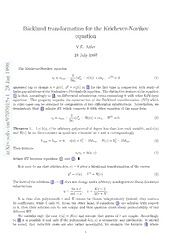Table Of ContentB¨acklund transformation for the Krichever-Novikov
equation
V.E. Adler
18 July 1997
6
9
The Krichever-Novikov equation
9
1
3
n ut = uxxx − (u2xx −r(u))+cux, r(5) = 0 (1)
a 2ux
J
8 appeared (up to change u = p(u˜), p˙2 = r(p)) in [1] for the first time in connection with study of
2
finite-gapsolutionsoftheKadomtsev-Petviashvili equation. Thedistinctivefeatureoftheequation
1 (1) is that, accordingly to [2], no differential substitution exists connecting it with other KdV-type
v
equations. This property impedes the construction of the Ba¨cklund transformation (BT) which
5
1 in other cases can be obtained by composition of two differential substitutions. Nevertheless, we
0
demonstrate that (1) admits BT which connects it with other equation of the same form
7
0
7 3
9 vt = vxxx − (vx2x −R(v))+cvx, R(5) = 0. (2)
/ 2vx
t
n
i Theorem 1. Let h(u,v) be arbitrary polynomial of degree less than 3 on each variable, and r(u)
-
v
and R(v) be its discriminants as quadratic trinomial on v and u correspondingly:
l
o
:s huuu = hvvv = 0, r(u) = h2v −2hhvv, R(v) = h2u −2hhuu. (3)
v
i
X Then formula
ar uxvx = h(u,v) (4)
defines BT between equations (1) and (2).
It is easy to see that relation h(u,v) = 0 gives a birational transformation of the curves
y2 = r(u), Y2 = R(v). (5)
Theformoftherelations(1)—(4)doesnotchangeunderarbitrarynondegeneratelinear-fractional
substitutions
ku¯+ℓ Kv¯+L
u = , v = .
mu¯+n Mv¯+N
It is clear that polynomials r and R cannot be chosen independently (indeed, they contain
10 coefficients, while h only 9). From the other hand, if equations (3) are solvable with respect
to h, then their solution can be not unique and then question arises about permutability of two
different BT.
We consider only the case r(u) = R(u) and assume that zeroes of r are simple. Accordingly
to [4] it is possible if and only if the polynomial h(u,v) is symmetric and irreducible. It should
be noted, that reducible cases are also rather meaningful, for example the formula (4) where
1
r = 0, h = (v − µu)2 defines the BT for Schwartz-KdV equation, from which the BT for other
KdV-type equations can be derived by standard substitutions.
The equation h(u,v) = 0 is known as Euler-Chasles correspondence (see e.g. [3]) and is
equivalent to the shift on the elliptic curve, which we take, without loss of generality, in the
Weierstrass form: r(u) = 4u3 −g u−g . The corresponding polynomial h depends on arbitrary
2 3
parameter µ and is of the form h = H(u,v,µ)/ r(µ), where
q
g
H(u,v,µ) = (uv+µu+µv+ 2)2 −(u+v +µ)(4µuv−g ). (6)
3
4
The relation H = 0 where u = ℘(z), v = ℘(z ± a), µ = ℘(a) is nothing but Euler form
of the addition theorem for Weierstrass ℘-function. Hence it is evident, that composition of
the correspondences H(u,v,µ) = 0, H(v,w,ν) = 0 coincides with composition H(u,v˜,ν) =
0, H(v˜,w,µ) = 0. Indeed, in the both cases w takes 4 possible values ℘(z ±a±b).
v˜ µ w
a -a
6 6
ν ν
a -a
u µ v
The Euler-Chasles correspondence is formally a particular case of (4) for u = const (but it
should be noted, that the constant solutions of the equation (1) are exhausted by zeroes of r). It
turns out that analogous commutativity property is valid for the BT (4) itself. Let u,v,v˜,w are
related by the BT as on the diagram above, that is
uxvx = H(u,v,µ)/α, vxwx = H(v,w,ν)/β, α2 = r(µ),
(7)
uxv˜x = H(u,v˜,ν)/β, v˜xwx = H(v˜,w,µ)/α, β2 = r(ν).
Let us remind that the constraint P(u,v,v˜,w) = 0 is called the nonlinear superposition principle if
itisnondegenerateoneachvariableanditsderivativeonxvanishesinvirtueofitself: Dx(P)|P=0 =
0.
Theorem 2. Nonlinear superposition principle for the BT (4), (6) is given by formula
P = k uvwv˜−k (uvw+vwv˜+wv˜u+v˜uv)+k (uw+vv˜)−
0 1 2
−k (uv+v˜w)−k (uv˜+vw)+k (u+v +w +v˜)+k = 0
3 4 5 6
where
g g g2
k = α+β, k = αν +βµ, k = αν2 +βµ2, k = 3k + 2k , k = 2k +g k ,
0 1 2 5 0 1 6 0 3 1
2 4 16
αβ(α+β) g αβ(α+β) g
k = −αν2 +β(2µ2 − 2), k = −βµ2 +α(2ν2 − 2).
3 4
2(ν −µ) 4 2(µ−ν) 4
Note that elimination of derivatives from (7) yields the relation
S = α2H(u,v˜,ν)H(v,w,ν)−β2H(u,v,µ)H(v˜,w,µ) = 0,
which is not the nonlinear superposition principle by itself. It is explained by reducibility of the
polynomial S = PQ, where P is written above and Q is obtained from P by substitution β to −β.
In contrast to the constraint P = 0 the constraint Q = 0 is not compatible with dynamics on x.
The work was supported by grants INTAS-93-166-Ext and RFBR-96-01-00128.
2
References
[1] I.M. Krichever, S.P. Novikov, Holomorphic fibering over algebraic curves and nonlinear equa-
tions, Uspekhi mat. nauk 35(6) (1980) 47-68
[2] S.I. Svinolupov, V.V. Sokolov, R.I. Yamilov, On the B¨acklund transformations for integrable
evolution equations, Dokl. Acad. Nauk SSSR 271(4) (1983) 802-805
[3] V.M. Buchstaber and A.P. Veselov, Integrable correspondences and algebraic representations
of multivalued groups, IMRN 8 (1996) 381-400
[4] V.E. Adler, A.B. Shabat, On the one class of Toda lattices, Teor. i Mat. Fiz. 111(3) (1997)
323-334
3

